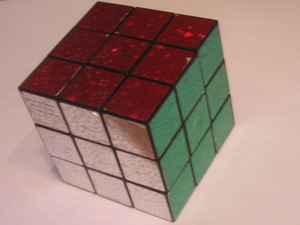Hey all, and welcome to the page that will hopefully teach you effectively how to solve a rubik’s cube every time you try. Let me begin this outline by saying that this meathod is by no means the quickest, but it is by far the easiest. You should begin your cube-solving career by taking notes from this page on all of the moves I am about to list, in order. Memorizing these moves (or algorithms) took me about one full day during this year’s spring break, and I am not one to claim to be an incredible memorizer. Each face of the cube is permanent. If you were to take it apart, you would find that the center squares cannot be altered. This means that each face has the center square solved already, it cannot be moved.
Your first step in solving your first rubik’s cube is to be able to interpret the notation I, as well as most tutorials, use. An example of the notation you will be seeing later in this article is: Ri, Di, R, D. The R and D indicate faces on the cube, the right and down face. the “i” indicated a counter-clockwise rotation, or “inverse”, no “i” assumes a clockwise rotation as if you were looking at that face.
Now that you can stumble through my notation, we can begin the solving of the cube! Begin by picking a color to be your top face. Let’s both pick green, just to better stay on the same page. Green will always be the “U” face in my notation, and correspondingly blue will always be the down face, or “D”. The first objective in solving your cube is to make a “+” sign with your green squares, on your green face. This does not require any fancy patterns or tricks, but it does take some practice. You have to look for each of the four green squares (on any face) that need to be moved to that same position on the green face. So pick up your cube, and look for a green square that is not a three-face corner.
Once you have located it, rotate its side so that the green square is on the bottom level of the cube. Then, rotate the bottom layer so that the color on the square that is not green corresponds with the color on that face. It sounds a little confusing, but image 1 is what it looks like. Then, rotate the face with these two colors in it so that the green is moved up to the green face. If you end up with the two colors reverse of what it should be, say the green square touching the red face and the red square touching the green face, use the algorithm Fi, U, Ri, Ui to switch the two. Through this process you will get a green cross on the green face.
The next step is to build in the green corners, but also put them in the correct corners, such as placing the “red, green, white” piece in the red, green, white square. The pieces only have one place to be, since the only sides with stickers are the sides that are exposed. These corner pieces only have three colors on them, so it is imperative to put them in not only a green corner, but the correct green corner. To do this, you have to get the right green piece below where it needs to go. In this case, keep the green face up, and find the corner piece that has red, green, and white on it. If the piece is on the green layer, use this algorithm to get it to the lower level, where it needs to be: Ri, Di, R, D. For this to work, you need to be facing the edge between red and white, or the two colors other than green in your corner piece.
You will be using this algorithm the most out of all, so get used to it :-). If the red, green, white piece was on the lower layer to begin with, then get it below where it needs to go (the red, green, white corner) and do the following algorithm repeatedly (five times at most): Ri, Di, R, D. And yes, it is the same algorithm as before, since it shuffles the piece between three corners. Repeat this strategy for the other three corners, and you will notice that not only is the green face solved, but the entire first layer is complete, and matches the center pieces on all faces. Congratulations!!! You may want to re-scramble your cube and be able to consistently get to this point before moving on, and for now always pick green as your top face.
If your cube does not look like image 2, re-read the page and try again. After you are confident consistently solving the first layer, you can begin solving the second, or middle, layer. This requires you to flip your cube so that what was your top face (green) is now your bottom face. Blue is now “U” in all of my notation. We need to find an edge (not a corner) piece on the top layer that does not have blue on it. Let’s say that you found a red/white edge piece. Whichever color is not on the top face (in this case, white) needs to be rotated to its corresponding side. Image 3 is what this should look like. Since red is to the right of white, the red square on this piece needs to be moved to the right. The right algorithm is : U, R, Ui, Ri, Ui, Fi, U, F. If the piece needs to be moved to the left (as is the case if red was the front face, and white was touching the blue center piece), you use the left algorithm : Ui, Li, U, L, U, F, Ui, Fi. There will be times when there are no pieces that do not contain blue. In this case, you will need to apply one of the algorithms as a shuffle, in order to attain such pieces. Nevertheless, using these two algorithms will always solve the second layer. Your cube should now look like image 4.
The last part of solving the cube is to solve the blue face, and at the same time have it match all other faces. Once again, we need to start by making a cross, just like we did for the green face. There are many different ways the blue “pattern” can turn out at this point. There can be just the center blue square, a line across the middle, or a backwards L that only uses three squares. If you get the line, you have to hold the cube so that the line is horizontal. With the “L”, the L must appear backwards, and reside in the upper left four boxes of the blue face, with the non-blue square on the upper left corner. If you get the blue dot with nothing else, do the following algorithm with any face as front, and then apply the rules I just stated when you do get one of those shapes. By the way, the L can take two runs of the algorithm to achieve a cross. Anyway, here it is: F, R, U, Ri, Ui, Fi. After one or more applications, you should have a cross of blue. No matter the cube or the shuffle of the cube, two side pieces will always line up correctly, be the faces across from each other or next to each other.
You need to hold these two correct faces so that the correct two are the right, and back face of the cube. If the correct colors are across from each other, put one of them as your front face, and do the following algorithm twice, instead of once as in the other case: R, U, Ri, U, R, U, U, Ri, U. By doing this, the only thing unsolved will be, possible, all four of your corners. You need to, next, find one of your corners that is in the correct position, but not necessarily flipped the correct way, but it can be if it is.
Position any correct corner, WITHOUT spinning any sides, to the lower right hand corner of the blue face (blue is still on top). Image 5 is what i mean. If no such corner exists (they are all in the wrong position) do this algorithm from any position as long as blue is still on top. U, R. Ui, Li, U, Ri, Ui, L. After a few runs of this pattern, you will get all four of the corners in the correct spot, but not necessarily in the correct orientation. If all four corners are not in the correct orientation, then don’t worry about positioning. If there are three that are incorrect, place the correct one in the top-right orientation, WITHOUT rotating any sides, just the whole cube. If there are two incorrect, place them on the bottom two spots, and one wrong should be put in the bottom right spot.
This last step is terrifying for your first few times. You need to be VERY confident in your spins, and just keep blindly doing it, as it appears to be scrambling everything you have worked so hard for. But trust me, it will work every time when done correctly. You are going to repeatedly do the first algorithm you learned (Ri, Di, R, D) until the blue square is on the top (where it should be). Once that happens, make sure that you completed the algorithm (the last down rotation doesnt’ look like it does any good, but it does), and rotate the top, blue layer counterclockwise (Ui), and repeat the algorithm until, again, the next blue corner square is facing upward. After this heart-numbing last step, the cube will appear to magically all come together, and it is an extremely gratifying experience.
As sad as it is, messing up this last step is best remedied by re-scrambling the cube and starting again, and believe me, you WILL have to do this. … Until you feel you could throw the God-forsaken cube to the moon, using only pure rage as fuel. But, after you master the last, nail-biting step the cube will become your best friend and you will find yourself showing everyone you have ever known. People will watch you doing it, think you have a complex pattern planned out, and scramble it behind their back, thinking they really have you fooled. But, in reality, this meathod is much easier than memorizing a long sequence of random patterns.
Here is the original place I found ALL of the algorithms above. It is a YouTube video by Dan Brown, and it will help you immensely, as this is pretty much a text version of his meathod, with added tips from someone who struggled through it.




